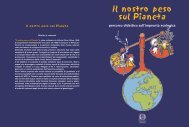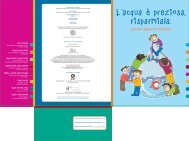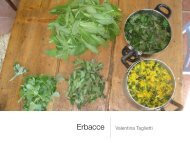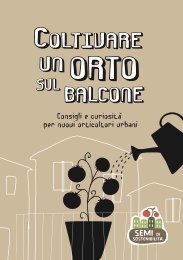Myanmar Protected Areas: Context, Current Status ... - Istituto Oikos
Myanmar Protected Areas: Context, Current Status ... - Istituto Oikos
Myanmar Protected Areas: Context, Current Status ... - Istituto Oikos
Create successful ePaper yourself
Turn your PDF publications into a flip-book with our unique Google optimized e-Paper software.
Agriculture in Makyone Galet (Lampi Island MNP) (A.Bonetti)<br />
Fisheries<br />
Although fishing is prohibited inside the park boundaries, a variety of fishing gears are used by<br />
subsistence and commercial fishermen for different catches. Lines, net and set gillnet are used for prawn<br />
fishing especially in War Kyunn area; traps, bag and artificial prawn baits are used to catch squid in the<br />
area of Makyone Galet, Ko Phawt, Sitta Galet and War Kyunn. A very small minority of fishermen has the<br />
necessary collection and carrying license from the Fishery Department. Local fishers use fishing vessels<br />
of small-medium dimension and they have frequent disputes with large fishing vessels illegally coming<br />
to catch near the shore destroying their traps and nets as well as the fishing ground. The collection of<br />
molluscs and sea cucumber is common amongst the Moken-Salone and Karen people respectively. The<br />
main market for the Lampi catches is neighboring Thailand. The illegal practice of dynamite fishing (or<br />
blast fishing) is common in this area and its destructive effects are visible on the corals around Lampi<br />
Island.<br />
Secondary occupations<br />
Grocery, general stores and tea shops are common in the five human settlements. Shopkeepers buy<br />
food supply directly from Kawthoung (border town in <strong>Myanmar</strong>) and/or Ranong (border town in<br />
Thailand) and resell to the local inhabitants and fishers from passing fishing boats. Hunting, especially<br />
by Karen migrants, is an illegal yet very lucrative livelihood. A single hunter can kill daily 10 to 20 animals<br />
such as mouse-deer, pangolin, giant lizard and wild-pigs, which he sells to the local fishermen or keeps<br />
conserved in cool box and then sends to Makyone Galet market. Although on small scale and with basic<br />
equipment, hunting in Lampi area could have severe consequences on the biodiversity of the site.<br />
Horticultural farming is only present in Makyone Galet village and War Kyunn work camp. Cashew, betel<br />
and rubber are the main crops of Makyone Galet and cashew betel and mango are primary cash crops<br />
in War Kyunn. The vegetables consumed in the area are mainly imported from Kawthoung.<br />
Very recently, due to the State policy encouraging rubber plantations under an agricultural.<br />
commercialization scheme, local people of Makyone Galet have started to convert the natural forest of<br />
Bo Cho Island into private rubber plantations. Logging is illegal but common in the site, especially in Bo<br />
Cho Island during rainy season when the transport of logs from the forest to the boats is made easier<br />
by water streams. The most common trees felled in the forest are Shorea sp., Dipterocarpus sp., Firmiana<br />
sp., Syzygium sp., Cinnamomum sp., Shorea farinose Fischer Mitra, Heritiera javanica (Blume), Artocarpus<br />
calophyllus Kurz, Hopea sangol Korth, Hopea odorata Roxb., Strombosia javanica Blume.<br />
7. Research<br />
The isolation of the Myeik Archipelago precluded for many years the possibility to conduct scientific<br />
expeditions in the area. Only recently <strong>Istituto</strong> <strong>Oikos</strong> and the local partner BANCA, in collaboration with<br />
other organizations like Ecoswiss, and with the support of Forest Department, had the opportunities to<br />
jointly organize some basic resource assessments in Lampi Island Marine National Park.<br />
Table 15 Survey reports about Lampi Island MNP<br />
Survey title Conducted by Timeframe<br />
Birds of the Mergui Archipelago:<br />
preliminary observations<br />
Andrea Bonetti 2006-2007<br />
Sea Cucumber Report Barry Bendel May 2008<br />
Socio-economic survey report Tint Tun and Aung Myint Oo May 2008<br />
Lampi fish report Tint Swe, San Tha Tun and Tint Tun September 2008<br />
Seagrass report Barry Bendel and Tint Tun December 2008<br />
Mangrove of Myeik Archipelago rapid<br />
survey assessment<br />
Hornbills of <strong>Myanmar</strong> (poster<br />
presented at the fifth International<br />
Hornbill conference in Singapore<br />
22-25 March 2009)<br />
Win Maung January 2009<br />
Lara Beffasti and Tint Tun March 2009<br />
Birds survey report San San Nwe and Nila Pwin April 2010<br />
Flora survey report Ei Ei Phyo and Myint Sein April 2010<br />
Livelihoods survey report Lara Beffasti and Saw Mon Theint April 2010<br />
Mammals survey report Khin Maung Soe, Thaw Sin, Pyi Phyo Swe April 2010<br />
Mangroves survey report Moe Min Win April 2010<br />
Marine resources survey report<br />
Birds survey report<br />
Saw Han Shein (plankton), Tint Tun, Tint<br />
Wai and Thuang Htut (seagrass and<br />
seaweeds)<br />
Sein Myo Aung, Saw Moises, San San<br />
Nwe and Nila Pwint<br />
In-depth Study of Lampi Island Marine National Park<br />
List of technical reports on Lampi Island MNP<br />
produced in the framework of the MABR and MEP projects.<br />
Surveys implemented in the period 2006-2008 were part of the Mergui Archipelago Biodiversity<br />
Research (MABR) project managed by Ecoswiss in partnership with <strong>Istituto</strong> <strong>Oikos</strong> and BANCA, funded by<br />
Stiftung Drittes Millennium. Surveys implemented in the period 2009-2010 were part of the <strong>Myanmar</strong><br />
Environmental Project (MEP) and Conservation and Sustainable Management of Lampi MNP (COSMO)<br />
project, both managed by <strong>Istituto</strong> <strong>Oikos</strong> in partnership with BANCA, co-funded by European Union,<br />
Regione Lombardia and Stiftung Dritt Millennium. Survey reports are reported in chronological order in<br />
Table 15. They are available under request (coverpage for contacts).<br />
116 117<br />
April 2010<br />
December 2010<br />
Crabs survey report Tat Su Mar December 2010<br />
Dugongs status survey report Tint Tun December 2010<br />
Focus Group Discussion Report Saw Mon Theint and Than Than Aye December 2010<br />
Molluscs survey report Tint Tun, Tint Wai and Thaung Htut December 2010<br />
Reptiles and amphibians survey report Kyo Soe Lwin and Khin Mar Tin December 2010<br />
Salone cultural ecology study Mya Thidar Aung and Moe Thidar Twe December 2010<br />
Sea turtles survey report Aung Hlaing Win and Htet Myint Aung December 2010






